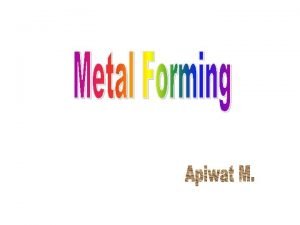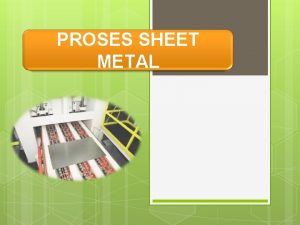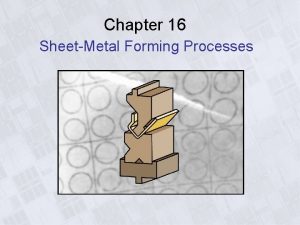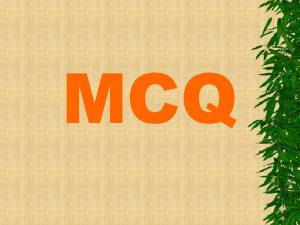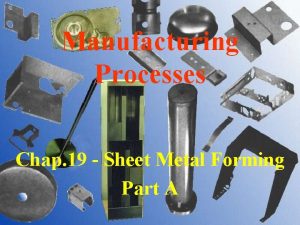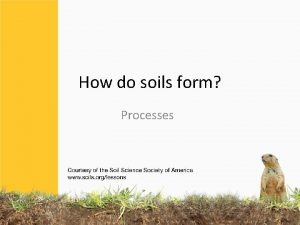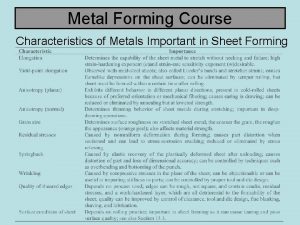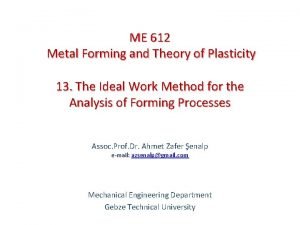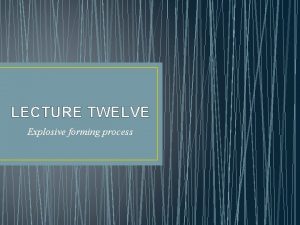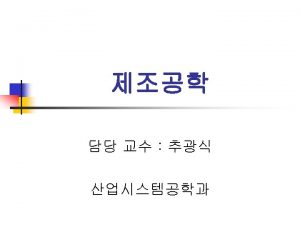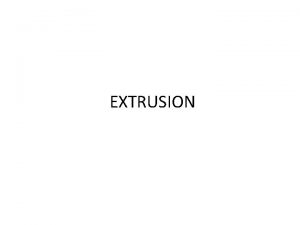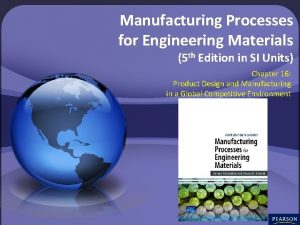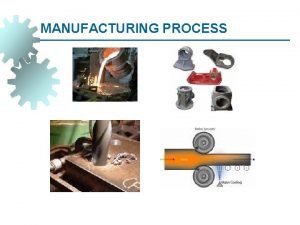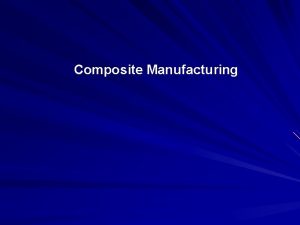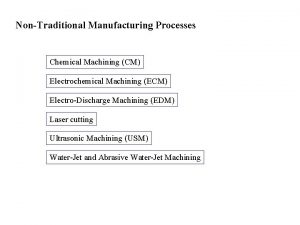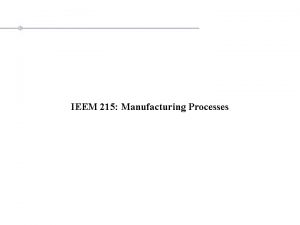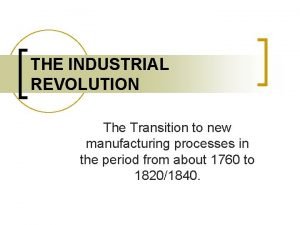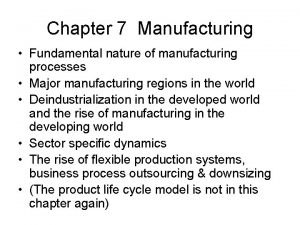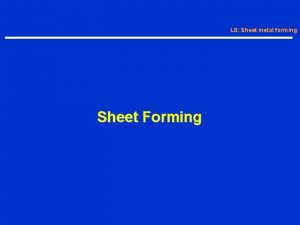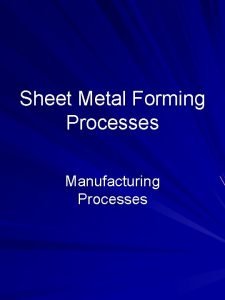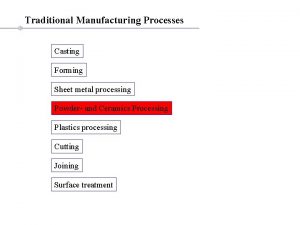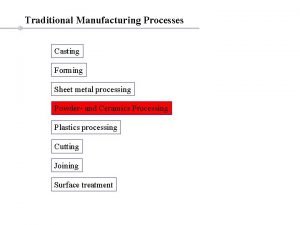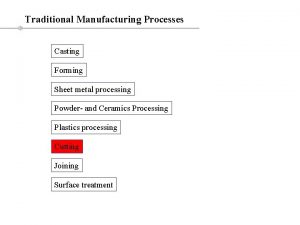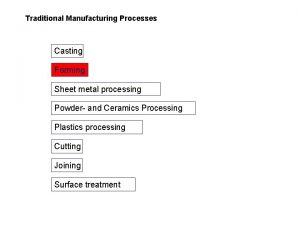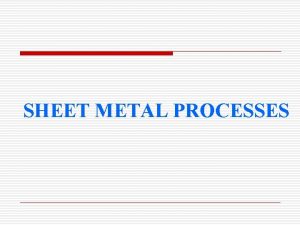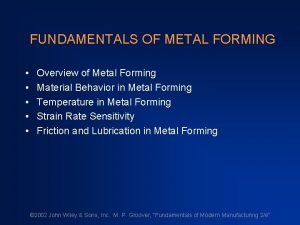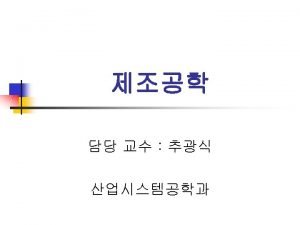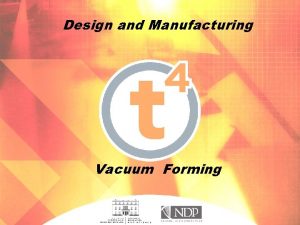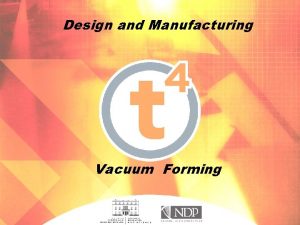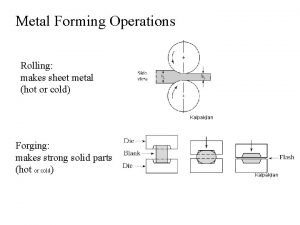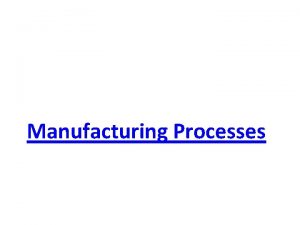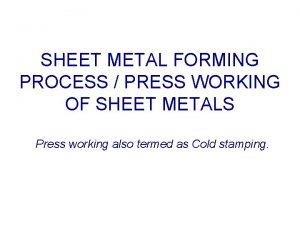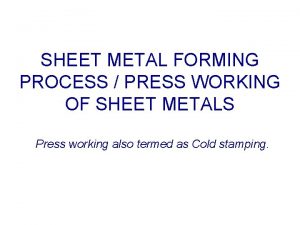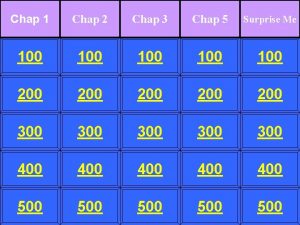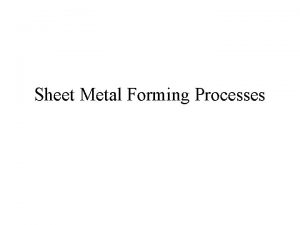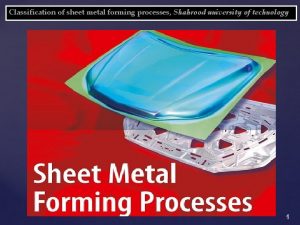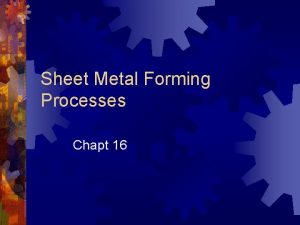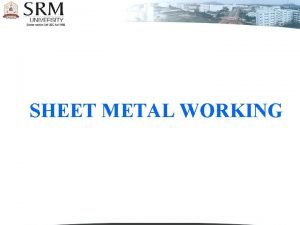Manufacturing Processes Chap 19 Sheet Metal Forming Part



























- Slides: 27

Manufacturing Processes Chap. 19 - Sheet Metal Forming Part A

Sheet Metal Forming • One of the oldest processes - more than 5000 years old. • Can create light weight and versatile shapes. • Carbon steel-most commonly used sheet metal. • Low cost, good strength & formability.

Sheet Metal Forming • Metal forming processes include: – Roll forming – Stretch forming – Drawing – Rubber forming – Spinning – Superplastic forming – Peen forming – Explosive forming – Magnetic-pulse forming

Sheet Metal Forming • Stamping operations include: • punching • lancing • blanking • piercing • embossing • perforating • bending • parting • flanging • notching • coining

Shearing • Most basic operation. • Sheet is subjected to shear stresses as punch and die interact. (Fig. 16. 2) • Components are punched hole and slug.

Shearing Mechanics • Edges of shear zone are not smooth. • Shearing starts with formation of cracks at top and bottom edges of workpiece. • Cracks eventually meet and separation of slug occurs. • Cracks generate the rough fracture surfaces. (fig. 16. 5 a left) • Rubbing of sheared edge and wall of punch & die create shiny burnished surfaces.

Shearing Mechanics • It is possible to obtain smooth edges via fine blanking. • Resulting Edges are highly square and smooth. – Sheet metal is placed between dies. (fig 16. 5 b) – Upper hold-down plate has a V-shaped stinger / protrusion. – Protrusion penetrates plate and creates a local compression stress state, locking it tightly and preventing distortion. • Upper and lower punches grip material and descend together. • Result is a smoother edged part (fig. 16. 5 a right)

Shearing Process Parameters • Punch & die shape & materials. • Punching speed • Lubrication • Clearance between punch and die

Clearance • Major factor that determines shape and quality of sheared edge. • With larger clearance, edges become rougher, deformation zone is enlarged. • Sheet is pulled into the clearance zone, making the sheared edges are rougher. • Deformation zone is narrower with higher punch speed: better surface is achieved.

Clearance • Depends on material type, temper, thickness, size of blank, proximity to edges of original sheet. • Clearances for softer materials are less than for harder materials. • Required clearance increases with sheet thickness. • Range between 5%-3% of sheet thickness but can vary widely. • A smaller clearance yields a better edge.

Burnishing & Burrs • Burnishing: – increases over roughing with increased ductility of sheet metal. – Decreases with increasing sheet thickness and clearance. • Burrs: – Consists of a thin edge or ridge. – Increase with clearance and ductility of sheet metal. – Dull tools increase their occurrence. – Have impact on subsequent operations and must be removed.

Edges • Edge quality improves with punch speed. • Edges can undergo severe cold work due to high shear strains. • Resulting work hardening affects formability of sheet in subsequent operations.

Punch Force • Product of shear strength of sheet metal and area being sheared. • Friction increases required force. F = 0. 7 T L (UTS) – T = sheet thickness – L = total length sheared (perimeter) – UTS = Ultimate Tensile Strength of material.

Shearing Operations • Blanking: when the slug is kept and rest is scrapped. • In piercing, the slug is discarded (scrap). – Simple Shearing: Blades are usually straight. – Piercing/Punching: Blades are curved or form a closed loop.

Shearing Operations • Die Cutting: – Slitting: (cutting a roll longitudinally with grooved rolls) • Similar to can opener action. – Slotting: (cutting a rectangular cutout) – Perforating (punching multiple holes) – Parting (shearing of sheet into 2+ pieces) – Notching (remove pieces from edges) – Lancing (leaving tabs without removing material) – Embossing: (a contoured form is shaped on the metal. ) – Nibbling: (cutting of overlapping slits)

Other Die Types • Compound Dies – Can perform several operations on the same strip in one stroke in one station. – Limited to simple shapes (limit is cost). – See fig. 16. 11. • Progressive Dies – Excellent for parts requiring multiple operations. – Good production rates. – Material is fed as a roll. Different operations are made on the same station with each stroke of a series of punches. (fig. 16. 11)

Die Materials • Generally made of tool steels and carbides. • Lubrication important for wear reduction and improved edge quality.

Sheet Metal Characteristics • Elongation – Sheet metal typically stretched in forming. – Elongation is the ability for metal to stretch without necking and failure. – High uniform elongation is desirable for good formability.

Sheet Metal Characteristics • Yield Point Elongation (YPE) – Behavior seen in low carbon steels. – Two yield points are present: upper and lower. – See Fig. 16. 12 • Once material yields it stretches farther in certain regions without increase in lower yield point while other regions have not yet yielded. • This produces Lueder’s bands.

Lueder’s Bands • A series of stretcher strain marks. • Are undesirable both cosmetically and for further coating operations. • Can avoid marks by diminishing YPE by reducing sheet thickness via cold rolling. • Must form material soon after cold rolling or YPE will reappear.

Some Sheet Metal Characteristics • Anisotropy (planar and normal): – directionality of sheet imparts different behavior in different planar directions. – Determines thinning of sheet metal during stretching. • Springback: – The elastic recovery of plastically deformed sheet after unloading. – Can cause distortion and loss of dimensional accuracy.

Formability • Ability of the sheet metal to undergo desired shape change without failure like necking or tearing. • Two basic types of sheet metal deformation exist: (a) stretching and (b) drawing • Formability prediction is important to study how a metal will deform under a particular set of tools. • Can be measured via cupping test and Forming Limit Diagram (FLD) among others. (Fig. 16. 14, 16. 15)

Forming Limit Diagram (FLD) • Sheet is marked with circle grid pattern (2 - 5 mm dia. ) • Blank is stretched over a punch and deformation is measured where failure (necking, tearing) occurred. • Specimens are cut to different widths to reveal uniaxial stretching and bi-axial stretching. • A FLD is constructed after subjected the specimens to forming test.

FLD Construction • Note that circle has deformed into an ellipse. • Major ellipse axis = major direction and magnitude of stretching. • Major engineering strain in this direction is ALWAYS positive, due to stretching.

FLD Construction • Minor ellipse axis = magnitude of stretching OR shrinking in transverse direction. • Minor engineering strain in transverse direction can be positive OR negative. • Reason: Poisson effect = a specimen becomes narrower when stretched.

FLD Construction • Data obtained at different locations of each sample are plotted in the figure. • Plotted curve = boundary between failure and safe zone. • Circle having 40% major strain and -40% minor strain has no tearing in that region. • Circle having 80% major strain and -40% minor strain would display a tear in that region. • A higher curve represents better formability of the material.

FLD Construction • It is desirable to have negative compressive (minor) strains. • Increasing sheet thickness raises the FLD curve (better). • Thicker sheets may be harder to bend, though. • Strains are better distributed if metal-die interface is lubricated.
 Wholesale sheet metal forming processes
Wholesale sheet metal forming processes Chap chap slide
Chap chap slide Sheet metal working
Sheet metal working Forming process in sheet metal
Forming process in sheet metal In a fusion welding process mcq
In a fusion welding process mcq Metal forming part
Metal forming part 4 soil forming processes
4 soil forming processes Cold working of metals
Cold working of metals Draw bead
Draw bead Theory of metal forming
Theory of metal forming Explosive metal forming
Explosive metal forming Metal forming
Metal forming Barrier screw extruder suppliers
Barrier screw extruder suppliers Manufacturing cost vs non manufacturing cost
Manufacturing cost vs non manufacturing cost Job costing vs process costing examples
Job costing vs process costing examples Commited cost
Commited cost Manufacturing cost vs non manufacturing cost
Manufacturing cost vs non manufacturing cost Additively
Additively Manufacturing processes for engineering materials
Manufacturing processes for engineering materials Classification of production system
Classification of production system Introduction to manufacturing process
Introduction to manufacturing process Pultrusion process
Pultrusion process Nontraditional manufacturing processes
Nontraditional manufacturing processes Traditional manufacturing processes
Traditional manufacturing processes Industrial revolution transition
Industrial revolution transition Fundamental manufacturing processes
Fundamental manufacturing processes Concurrent processes are processes that
Concurrent processes are processes that Venn diagram of solids liquids and gases
Venn diagram of solids liquids and gases
